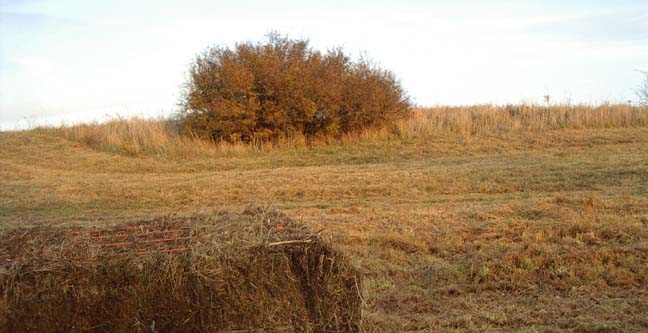

The long grasses around the upper car park have also been forage harvested. Some of the woody scrub in the far north-east corner have also been cut down allowing a view over Old Erringham Farm. The Dogwood and Wild Privet has not been tackled yet. (Should these shrubs be dealt with before they distribute their berries and seeds?) Oil Seed Rape plants are growing on the middle slopes in an eroded area where the scrub has been uprooted.
 21
October 2003
21
October 2003
On
a sunny midday, there was nothing of note around except that a Wall
Brown Butterfly fluttered by, landing
briefly on the scrubby area of the middle slopes.
30
August 2003
On
the upper slopes, the dried and parched grasses did not support the usual
number of butterflies, just a handful of both Common
Blues, Meadow Browns,
and
a few Small White Butterflies
and Small Heaths.
South-west of the bridge over the A27, a Wall
Brown had a mid-flight contention with
another one of its own species or a mistaken courtship with a Meadow
Brown.
(There
was a complete absence of Small Tortoiseshell
and Gatekeeper Butterflies.)
20
August 2003
The
second brood Adonis
Blue Butterflies are now out and flying
around in their brilliant blue on the lower slopes
of Mill Hill. One even ventured up amongst the
the brambles and long grasses (loosely
dominated by the False Oat Grass, Arrhenatherum) immediately
south of the reservoir on the upper slopes. On the upper slopes,
the handful of Common Blue Butterflies
were
a quite striking blue colour as well. There were a couple of silver
chysalids of the 6-spotted Burnet Moths
on the long grass stems. A couple or more of Painted
Ladies produced a splash of colour in
the grasses.
|
|
|
|
|
|
 15
August 2003
15
August 2003
All
the meadows on the upper slopes had grown parched and in places there was
a serious Dogwood intrusion in some of the longer grasses meadows.
In the meadow to the south of the Canadian copse, I was a bit puzzled about
some of the female brown butterflies of the blue family: they were either
Common
Blue females or Chalkhill Blue females. My
favourite choice would be the Common Blue
because this was long grass (over 40 cm high) and it is not Horseshoe
Vetch terrain. The butterfly is shown on the
right. I have identified it as Chalkhill
Blue female. This incidence has occurred
on a handful of occasions this year.
20
July 2003
Early
Evening
I
returned to Mill Hill in the early evening and
I was surprised that on the lower slopes, the
abundance of Chalkhill Blues
was simply not on view any more. There were still plenty of Chalkhill
Blues around but I only counted about thirty
and most of them were hiding and only rose into flight because I disturbed
them. On the approaches to the Vetch Trail from
the south a handful of Wall Browns
left the chalk path and half a dozen 6-spotted
Burnet Moths buzzed around the Knapweeds.
There were a handful of Speckled Wood Butterflies
in the scrub, Meadow Browns
(including some nymphalid-sized overlarge specimens) and Gatekeepers
everywhere. In the long grass just to the south of the reservoir, there
was one Marbled White
resting, looking past its prime, and to my surprise in a small garden plot
area, I spotted about sixty Chalkhill Blue
Butterflies resting on the stems of the grasses
in a manner reminiscent of Common Blues.
 |
 |
 |
 |
Chalkhill Blues in the long grass near the reservoir (Click on images for enlargements)
15
July 2003
Butterfly
List: Meadow Browns
(75+), Marbled
Whites (30+), Chalkhill
Blue (2), Large
Skipper (5+), Gatekeeper
(10+), Red
Admiral (3+), Holly
Blue (two near the gardens at the extreme southern end).
Adur
Butterfly List (from 14 July 2003) not recorded on Nature Notes